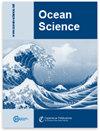南海东北部反气旋涡与半日内潮相互作用的数值研究
IF 4.1
3区 地球科学
Q2 METEOROLOGY & ATMOSPHERIC SCIENCES
引用次数: 0
摘要
摘要我们利用高时空分辨率数值模式研究了南海东北部大陆坡上反气旋涡(AE)与半日内潮(SIT)之间的相互作用。两个主要发现如下:首先,AE 促进了低模 SIT 向高模 SIT 的能量转换。此外,产生项表明,能量还以平均 3.0 mW m-2 的速率从 SIT 场转移到涡场(在涡直径上整合时,占 SIT 输入能量通量的 7%)。其次,AE 可以通过折射、散射和反射低模 SIT 来改变潮汐引起的耗散的空间分布。SIT 的相位和群速度受到涡场的显著影响,导致内部潮汐射线向北或向南移动。这些发现加深了我们对 AE 和 SIT 之间复杂的相互作用及其对能量转换、波浪传播和沿岸过程的影响的理解。本文章由计算机程序翻译,如有差异,请以英文原文为准。
Numerical investigation of interaction between anticyclonic eddy and semidiurnal internal tide in the northeastern South China Sea
Abstract. We investigate the interaction between an anticyclonic eddy (AE) and semidiurnal internal tide (SIT) on the continental slope of the northeastern South China Sea (SCS), using a high spatiotemporal resolution numerical model. Two key findings are as follows: first, the AE promotes energy conversion from low-mode to higher-mode SIT. Additionally, production terms indicate that energy is also transferred from the SIT field to the eddy field at an average rate of 3.0 mW m−2 (accounting for 7 % of the incoming energy flux of SIT when integrated over the eddy diameter). Second, the AE can modify the spatial distribution of tidal-induced dissipation by refracting, scattering, and reflecting low-mode SIT. The phase and group velocities of the SIT are significantly influenced by the eddy field, resulting in a northward or southward shift in the internal tidal rays. These findings deepen our understanding of the complex interactions between AE and SIT, as well as their impacts on energy conversion, wave propagation, and coastal processes.
求助全文
通过发布文献求助,成功后即可免费获取论文全文。
去求助
来源期刊

Ocean Science
地学-海洋学
CiteScore
5.90
自引率
6.20%
发文量
78
审稿时长
6-12 weeks
期刊介绍:
Ocean Science (OS) is a not-for-profit international open-access scientific journal dedicated to the publication and discussion of research articles, short communications, and review papers on all aspects of ocean science: experimental, theoretical, and laboratory. The primary objective is to publish a very high-quality scientific journal with free Internet-based access for researchers and other interested people throughout the world.
Electronic submission of articles is used to keep publication costs to a minimum. The costs will be covered by a moderate per-page charge paid by the authors. The peer-review process also makes use of the Internet. It includes an 8-week online discussion period with the original submitted manuscript and all comments. If accepted, the final revised paper will be published online.
Ocean Science covers the following fields: ocean physics (i.e. ocean structure, circulation, tides, and internal waves); ocean chemistry; biological oceanography; air–sea interactions; ocean models – physical, chemical, biological, and biochemical; coastal and shelf edge processes; paleooceanography.
 求助内容:
求助内容: 应助结果提醒方式:
应助结果提醒方式:


